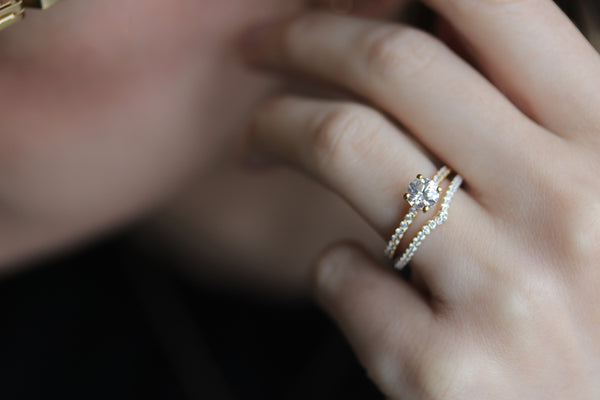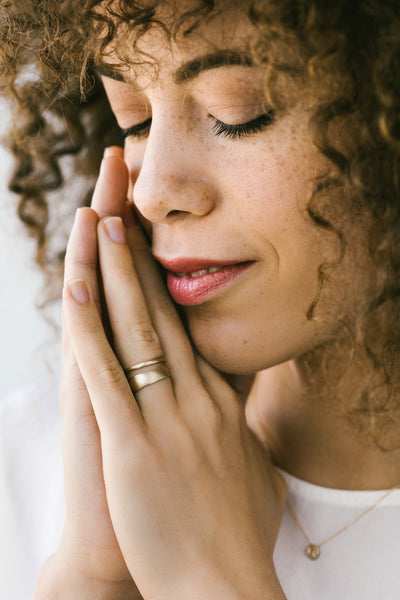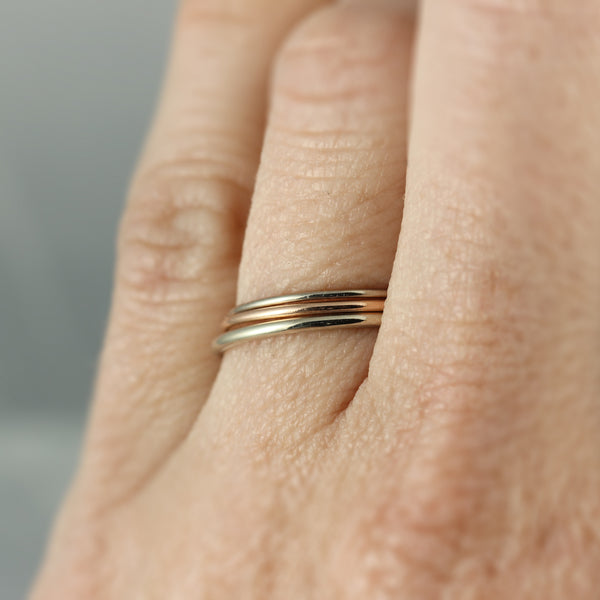Ordering a ring without trying on different widths and thicknesses first can sometimes be tricky. This post is here to help you figure out the dimensions that are right for you. First, it's helpful to understand the terms that jewelers use in referring to the different aspects of a ring. Below is a diagram illustrating the various dimensions of a ring.
So how wide and thick should your ring be? Well, only you can answer that question, but here are a few factors to better guide you.
- Wider bands can be less comfortable than narrower bands
- Narrower bands are better for people with larger knuckles
- Comfort-fit bands are usually 1.5mm thick or thicker
- 1.5mm thick or thicker is better for durability
- Slimmer fitting bands are generally more comfortable for people who are sensitive to the feeling of a ring between their fingers
- If you are pairing rings, try to match the thickness or come close
- Mixing up widths in a ring stack can create a more interesting look

Width (Wide vs. Narrow)
Wider bands are less comfortable than narrow bands and can be harder to take on and off. Wide bands also fit tighter, so you will often have to size up for a wider band. If you have larger knuckles than the base of your fingers, a narrower band (4mm and under) will fit better because you won't have to size up as much. With larger knuckles, it's preferred to have the ring fit as tight as possible since once you get it over the knuckle, it will still fit a bit loose at the base of the finger.

There is no right or wrong width for your wedding band, even if you pair it with another ring. You do want to consider the total width of all the rings stacked together and how wide you'd like the total to be. Most commonly, people will match the width of their wedding band to that of the engagement ring, but mixing widths can create a unique look. Stylistically it tends to look best to either match the width or so that the wider band is at least twice the width as the narrower band to create a nice contrast.

Thickness (Thick vs. Thin)
Thickness plays a significant role in the durability of a ring, and every .25mm added to thickness can increase the durability. We recommend a minimum thickness of 1.5mm for people who do a lot with their hands or if you want a comfort-fit band.
Rings thinner than 1.5mm are more likely to bend or change shape over time. This is not the end of the world since your fingers aren't round. So a ring that becomes slightly oval over time can feel a little more comfortable, and most rings can easily be hit back into round by a jeweler in the future.
 Thinner bands are often preferred by people who are very sensitive to the feeling of a ring between their fingers, as a thinner band will be less noticeable. Though thinner, slim-fitting bands are too thin for a comfort-fit. However, some people find the thickness required for a comfort-fit to be less comfortable than a slim-fitting band. Thinner bands can also feel a little sharper on the edges, depending on the shape, like a thick classic band.
Thinner bands are often preferred by people who are very sensitive to the feeling of a ring between their fingers, as a thinner band will be less noticeable. Though thinner, slim-fitting bands are too thin for a comfort-fit. However, some people find the thickness required for a comfort-fit to be less comfortable than a slim-fitting band. Thinner bands can also feel a little sharper on the edges, depending on the shape, like a thick classic band.If you pair your ring with another ring, it's a good idea to go for a similar thickness so that one band doesn't overshadow the other. For example, if your engagement ring is 1.5mm thick, shoot for something at least 1.25mm thick. If your engagement ring is much thicker at the top than the bottom, you could go for a thickness that matches the middle thickness.

We also have this handy dandy downloadable .pdf chart that you can print and cut out to try on different widths on you finger -> Ring Width Guide


